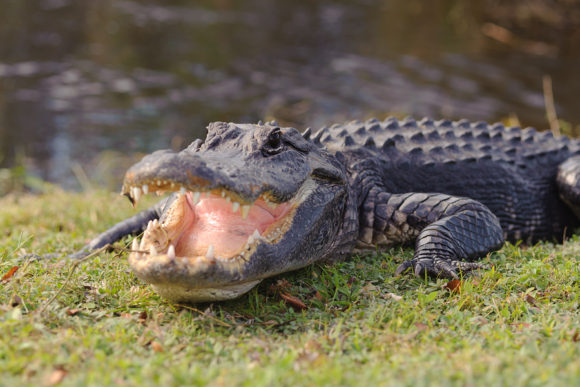Walt Disney Co. has had more than 240 “nuisance” alligators captured and killed over the last 10 years at its Florida theme park property, according to state records. The records reveal the park’s constant struggle to keep alligators away from humans in a region where the creatures live and breed.
Last week, a 2-year-old boy at the Walt Disney World Resort died after an alligator attack at the edge of a hotel lagoon. Critics questioned why Disney hadn’t posted signs warning guests of the presence of alligators in the area; the company has since installed such signage.
“You’ll never be able to get them all,” said Florida trapper Ron Ziemba, who helped trap and kill nuisance alligators on Disney World property for five years until late 2015. “There are just so many canals, so many waterways. The gators travel a lot.”
As humans encroach into alligators’ habitat, encounters are inevitable, Ziemba said, noting that he has removed the reptiles from a Disney parking lot and from the lobby of a nearby hotel not run by the resort.
Harvest Permit
Under Florida’s Statewide Nuisance Alligator Program, Disney World’s property has been designated a “targeted harvest area,” meaning the state has issued a blanket permit for the taking of problem alligators in the area. The state considers an alligator a nuisance if it is at least 4 feet in length and is believed to pose a threat to people, property or pets.
Disney’s alligator harvest permit, which was issued in 2009 and expires in 2019, specifies that the resort can remove up to 300 alligators of more than 4 feet in length from the area during the 10 years covered by the agreement. Disney has been removing an average of 24 large alligators annually from its property, or about six fewer per year than the permit would allow. From May 2006 through May 2016, 239 nuisance alligators were removed from Disney property and euthanized, according to documents provided by the state. That does not include six that were removed in the wake of last week’s attack.
The permit designates a state-authorized trapper to remove problem alligators. An additional “special purpose permit” authorizes certain resort employees to trap and kill alligators without a state trapper “where immediate action is required.”
A Disney spokeswoman declined to say whether company employees have euthanized alligators.
“Walt Disney World is responsible and has a comprehensive approach that helps to reduce the potential for interactions between people and alligators,” the Disney spokeswoman said in a statement, noting that staff members are taught to report alligator sightings.
Disney has set aside nearly a third of its land outside Orlando as a wildlife conservation area, she said, and smaller alligators are relocated there.
The state of Florida supports killing rather than relocating large alligators, because they are likely to return to their original location or become a problem in the area where they are relocated.
Trappers generally receive a $30 state stipend for each alligator they remove, but the bulk of their trapping income is from selling the meat and hides of those alligators.
Alligator Country
Florida has an estimated 1.3 million wild alligators, or about one for every 15 residents, according to the Florida Fish and Wildlife Conservation Commission. While attacks on humans are rare, the state’s Nuisance Alligator Program receives many complaints about problem alligators. Between 2005 and 2014, the program averaged about 15,000 requests for help each year and authorized the killing of more than 8,000 alligators annually.
U.S. alligator populations declined drastically during the first half of the 20th century, and alligators were listed as an endangered species in 1967, according to the U.S. Fish and Wildlife Service. Since then, with careful management, the population has recovered, and the species was delisted in 1987, though it is still under management by states where it is found.
Tracy Howell, 53, is the state-designated trapper responsible for Disney’s targeted harvest area. He does not work for the theme park, but is authorized by the state to remove and euthanize nuisance alligators when the company identifies a problem.
“Disney has a really good alligator program,” Howell said. The company is diligent, he added, about trying “to keep large alligators away from the public.”
Records show the largest alligator trapped on Disney World property in the last 10 years was 13 feet long and was captured in January 2015. Most of the alligators taken from the area were under 7 feet. Alligators are often removed from the property alive and killed later, but Howell says he tells his trapping team to euthanize them on the spot if they feel threatened.
Trappers say they generally kill alligators with a bullet to the base of the skull, sometimes delivered by a “bang stick,” a specialized firearm that discharges upon contact with the alligator underwater. Capturing reptiles alive has the benefit of buying time for processing the meat, because the reptiles begin to rot if they aren’t placed in a cooler within an hour of death, Ziemba said.
“If we’re moving them live, we have cages that we put them in,” Howell said. “You would never even know we were moving an alligator down the highway.”
(Reporting by Jeffrey Dastin in New York; Editing by Sue Horton and Leslie Adler)
Related:
- Florida Theme Parks Review Safety Policies After Fatal Alligator Attack
- Legal Experts Expect Disney to Settle If Family Sues Over Alligator Attack
Was this article valuable?
Here are more articles you may enjoy.



 More Floridians Moving Out Due to Housing, Insurance Costs, Cotality Report Says
More Floridians Moving Out Due to Housing, Insurance Costs, Cotality Report Says  Global Q1 Commercial Insurance Rates Drop 3%, but US Casualty Bucks the Trend
Global Q1 Commercial Insurance Rates Drop 3%, but US Casualty Bucks the Trend  New York High Court Unleashes Expanded Liability for Pet Owners
New York High Court Unleashes Expanded Liability for Pet Owners  Florida Bill Advances, Would End Board of Engineers, Other Professional Agencies
Florida Bill Advances, Would End Board of Engineers, Other Professional Agencies 

